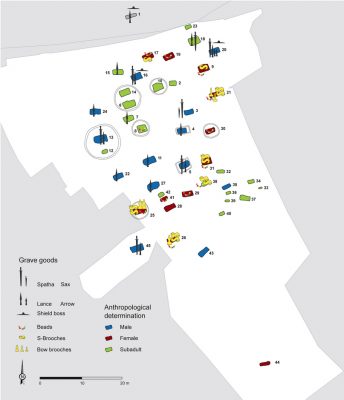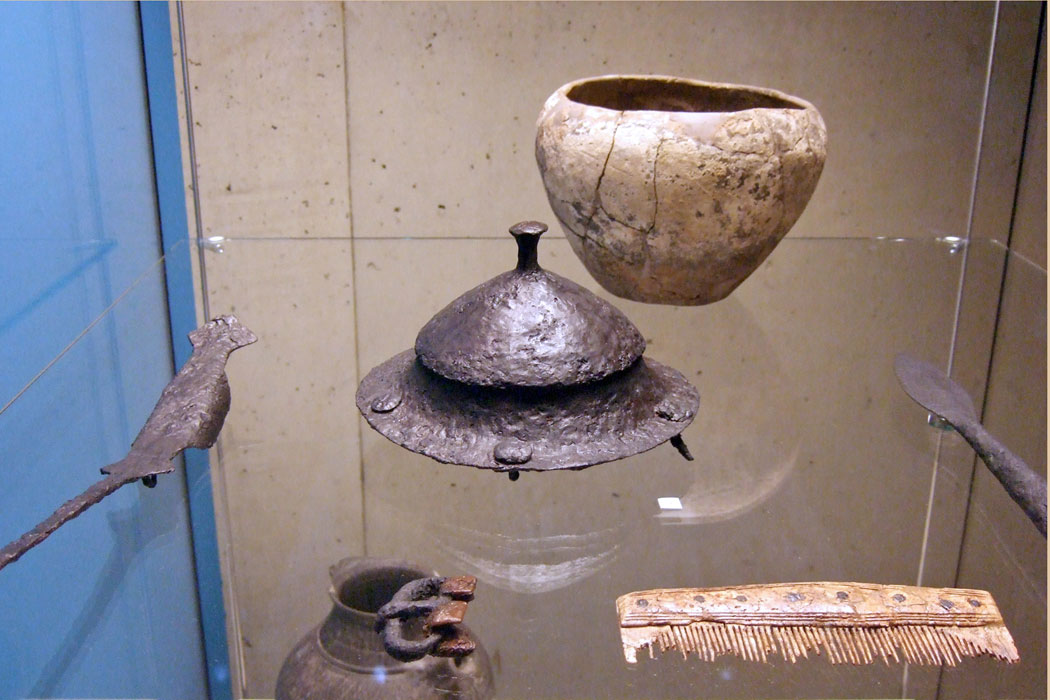How should we understand the migration through Europe in the 5th and 6th centuries? New research into ancient DNA and Isotopes shed light on people interacting across long distances. But did they also move around?
Residential changes of people during the Migration Period are crucial for understanding what happened during the 5th and 6th centuries inside Europe. Was it only small contingents of people, who moved around? Or did mass migrations take place?
For along time, answers have been marred by the inadequacy of the written sources pared by the controversies of how to understand the archaeology, which has been carried out for more than a hundred years.
Now, these old questions are once more at the fore of scholarly debates, fuelled by new archaeological studies of both aDNA (ancient DNA) and Isotopes of people found together in burial grounds. The measurement of isotopes may yield information about where people grew up and their diet – both as children and grown-ups. Ancient DNA may present us with evidence of family connections between people, who were buried inside the same cemetery and thus give us evidence of their community and social organization. It may also – perhaps – present us with information about the long-distance migrations, which the emptying of whole central and eastern European regions otherwise seems to indicate.
Thuringia
One such study of 48 burials from the Thuringian cemeteries of Rathewitz and Obermöllern (Burgenlandkreis, Sachsen-Anhalt, Germany was published in 2012 by a team led by Corinna Knipper. The burials date from the late 5th to the mid 6th century.
Modern vegetation- and water-samples provided detailed information about the isotopic composition of the biologically available strontium of geological units in the area. Based on this, It appears that although the rich furnishing of the burials provided evidence for contacts with many different regions, only one individual (7.1%) in Rathewitz and three (12.5%) in Obermöllern could be characterised as isotopically nonlocal to the sites. These individuals were buried among the locals and their graves were similarly equipped. In contrast, many nonlocal grave goods were found with individuals who might be isotopically characterised as locals. These graves might be fitted with a mixture of local items and pieces indicating several different source areas. This suggests the existence of strong interregional ties among the members of the local elites.
Further, the changes in outlay of the graves could not be associated with newly arriving groups; rather, they resulted from a change in funeral customs of the indigenous population from cremation to inhumations and/or small-scale changes of the burial places. Overall, the evidence reflects individual residential changes rather than large-scale movements of groups, the scientists concluded
Pannonia

A somewhat different conclusion was the result of a study of a migration period cemetery in Szólád in present-day Hungary. This is historically known as the epicentre of the Lombard immigration to Italy in the mid 6th century and the question was what might be said about the composition and source of the people, who lived there.
All-in-all 44 skeletons of adults and sub-adults were excavated at this 6th century burial ground. Anthropological, molecular genetic and isotopic analyses helped to understand the history behind the people, whose remains witnessed the upheavals in the migration period. The results may be summarised like this
1) Skeletal stress markers as well as traces of interpersonal violence were found to occur frequently.
2) Evidence of possible direct maternal kinship was identified in only three pairs of individuals
3) According to enamel strontium isotope ratios, at least 31% of the individuals died at a location other than their birthplace and/or had moved during childhood. However, it appears that the movement may not have been long-distance. The isotopical evidence did not allow such a conclusion.
4) Owing to the virtual absence of Szólád-born adults in the cemetery, the settlement was presumably abandoned after approximately one generation or 20 years.
In general, the population is believed not to have come from afar. Only a couple of individuals presented with divergent isotope profiles indicating a move to the region. However, it is characteristic that the males on average had a more local profile than some of the females, thus pointing to a community governed by patrilocal residential rules. At some point, the whole community moved from their original (nearby) location to Szólád. At this point a few new residents moved in from afar. However, in general the composition of the community remained the same. After twenty years the site was apparently abandoned. This evidence is in agreement with the limited chronological range of the grave goods as well as the historical records, which attest to a short phase of Lombard settlement in Pannonia before the people born in the region moved away. But this is speculation until more such communities have been studied in extenso.
However, on another level, the burial community was characterised by both biological and cultural heterogeneity. On one hand, the group of males seems to have had abundant access to animal protein, while women in the group on average had to be content with millet, amaranth and possibly sedges that may have been available on the shores of Lake Balaton. Children were weaned between two or three years and seem to have suffered from anaemia and malnourishment. This was obviously a fragile community.
Both the rich offerings of weaponry in some of the male burials and the recurring evidence of interpersonal violence further point to the difficult political situation during the Migration Period as does a study of the grave constructions and the grave goods. Different artefacts – both weaponry and brooches – indicates that the people from Szólád had cultural contacts with others inside a region covering south-western and central Germany, Moravia and the middle Danube as well as Italy.
It seems, this was not a close reproductive community, but a fluid group of people obviously on the move. “The inferred dynamics of the burial community are in agreement with an hypothesis of a highly mobile lifestyle during the Migration Period and a short-term occupation of Pannonia by Lombard settlers as conveyed by written sources”, conclude the authors.
Nevertheless, later comparisons between this immigrant group in Szólád in the region of Lake Balaton and the people, who lived 46 km away at Keszthely-Fenékpuszta have demonstrated that on the one hand there were clear differences, e.g. in the respective degrees of mobility, but on the other there were also indications of contact and a temporary coexistence between the Lombards and the people of the early Keszthely-culture.
Conclusion
Such studies are as yet few and conclusions can only be preliminary. However, a research project is under way, which aims to find funding for more such studies of “communities” of people in order to better understand the combinations of their visions of community, cultural networks and their migratory movements through Europe in the Early Middle Ages. Currently a group under the aegis of Patrick Geary is working to turn it into a proper research project. However, so-far funding has not been ready available and it appears that the professor from Princeton is still doing the rounds to drum up financing for these expensive studies.
Central questions for this research are(as formulated by Patrick Geary)
1) How should we understand the social structure of the militarized communities within and without the Empire in the 6th century? Do these communities appear to be organized according to kinship, social status, gender, or some other criteria?
2) Are the populations that are buried in these cemeteries primarily a portion of the indigenous population that has taken on new cultural, social, and behavioural models?
3) Or: Are the people buried in the cemeteries in Italy actually the descendants of those who lived in Pannonia prior to 568?
It is obvious that by studying specific cases – cemeteries and local communities – new and much more nuanced information about the events in the migration period might be obtained.
SOURCES:
Mobility in Thuringia or mobile Thuringians: A strontium isotope study from early medieval Central Germany.
Corina Knipper, Anne-France Maurer, Daniel Peters, Christian Meyer, Michael Brauns, Stephen J. G. Galer, Uta von Freeden, Bernd Schöne, Harald Meller, Kurt W. Alt,
In: Population Dynamics in Prehistory and Early History: New Approaches Using Stable Isotopes and Genetics
Ed by Elke Kaiser, Joachim Burger, Wolfram Schier
Walter de Gruyter 2012
Schmelztiegel Balaton? Zum Verhältnis „langobardischer“ Einwanderergruppen und (vor-) langobardenzeitlicher romanischer Bevölkerung am Balaton – Szólád und Keszthely-Fenékpuszta zwischen Archäologie und Isotopie
By David Peters, Corina Knipper; Uta von Freeden, Wolfgang Müller, Anne-France Maurer, Kurt W. Alt, and Tivadar VidaIn: Mensch, Siedlung und Landschaft im Wechsel der Jahrtausende am Balaton. Castellum Pannonicum Pelsonense. Vol. 4, Chapter:
Ed. by Orsolya Heinrich-Tamaska and Péter Straub, Verlag Marie Leidorf 2014, pp.337-360
Lombards on the Move – An Integrative Study of the Migration Period Cemetery at Szólád, Hungary
By Kurt W. Alt, Corina Knipper, Daniel Peters, Wolfgang Müller, Anne-France Maurer, Isabelle Kollig, Nicole Nicklisch, Christiane Müller, Sarah Karimnia, Guido Brandt, Christina Roth, Martin Rosner, Balász Mende, Bernd R. Schöne, Tivadar Vida, and Uta von Freeden
In: PloS One, (2014), Vol 9 (11) (Open Access)
Rethinking Barbarian Invasions through Genomic History
By Patrick Geary
In Hungarian Archaeology E-Journal. 2014/ autumn
Using Genetic Data to Revolutionalize Understanding of Migration History
By Patrick Geary
IAS 2013
Donne e uomini, parentela e memoria tra storia, archeologia e genetica. Un progetto interdisciplinare per il future
By Christina La Rocca
In: Archeologia medievale (2011), Vol. 38, pp. 9 – 18
SEE & LISTEN:
FEATURED PHOTO:
Lombard man’s grave goods from Szólád Hungary. Source: wikipedia/James Steakley
